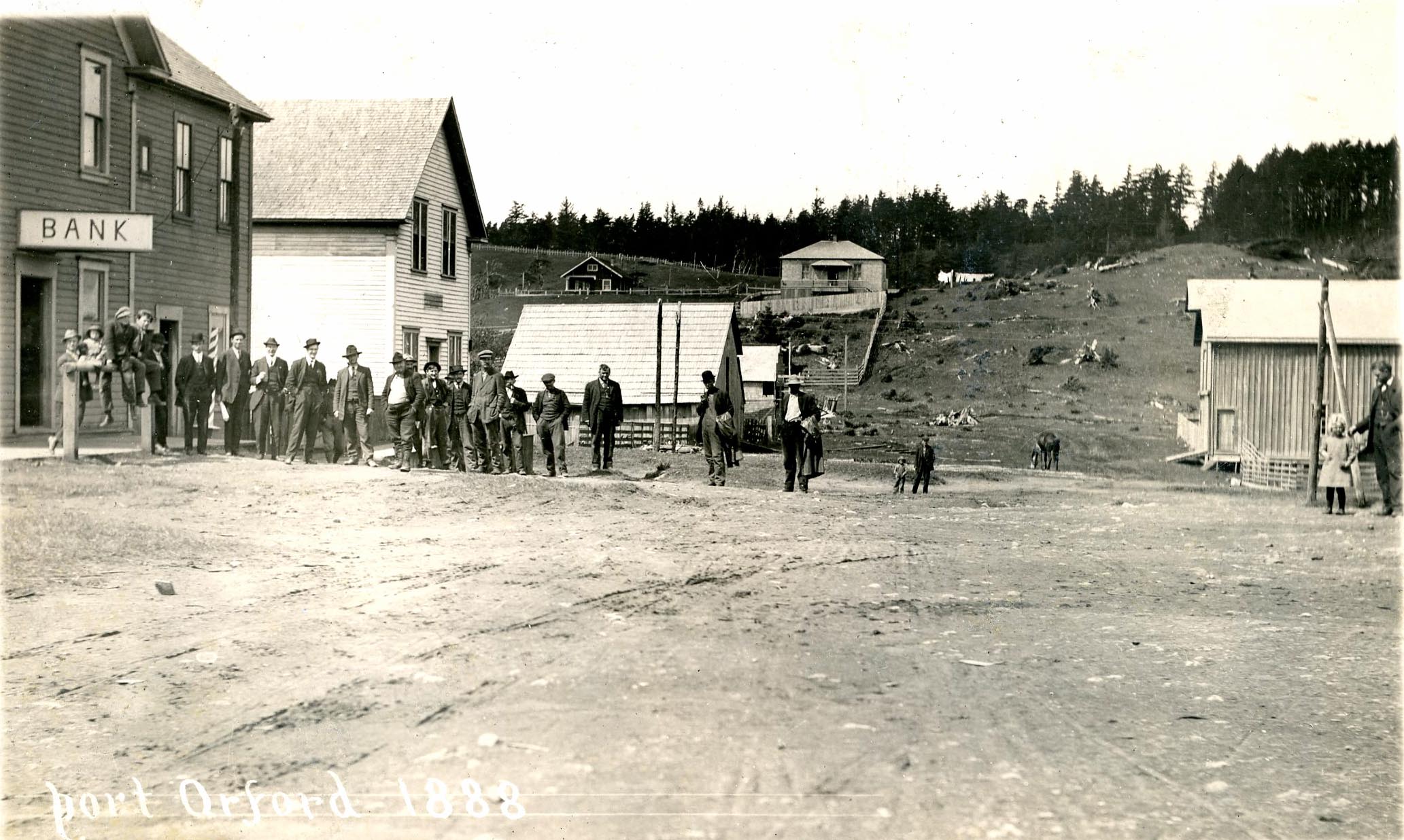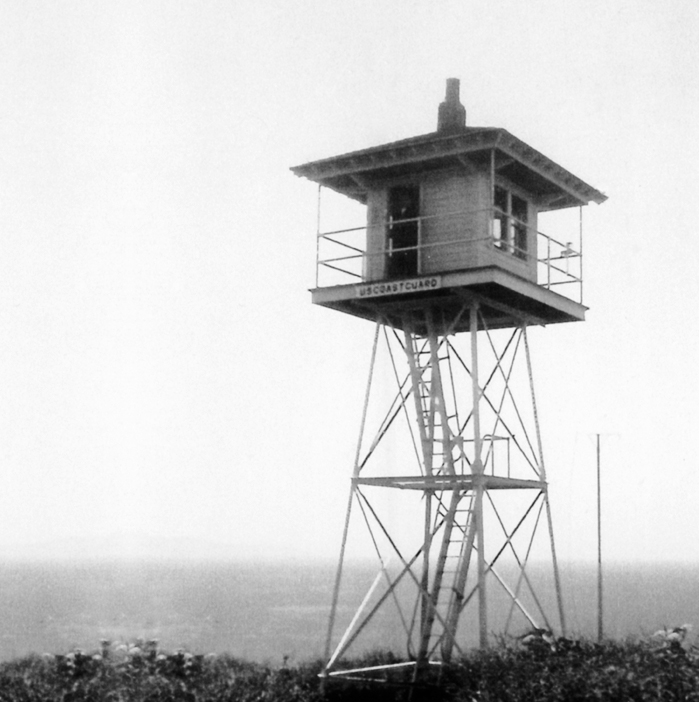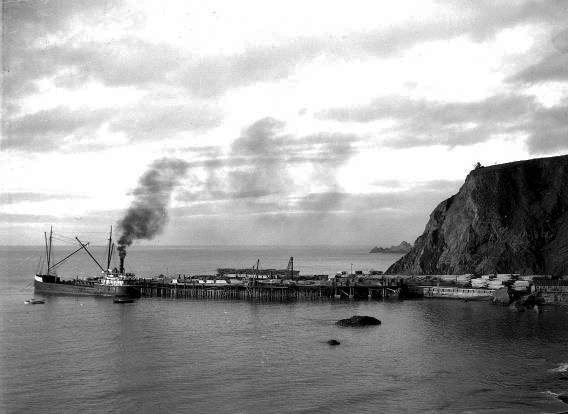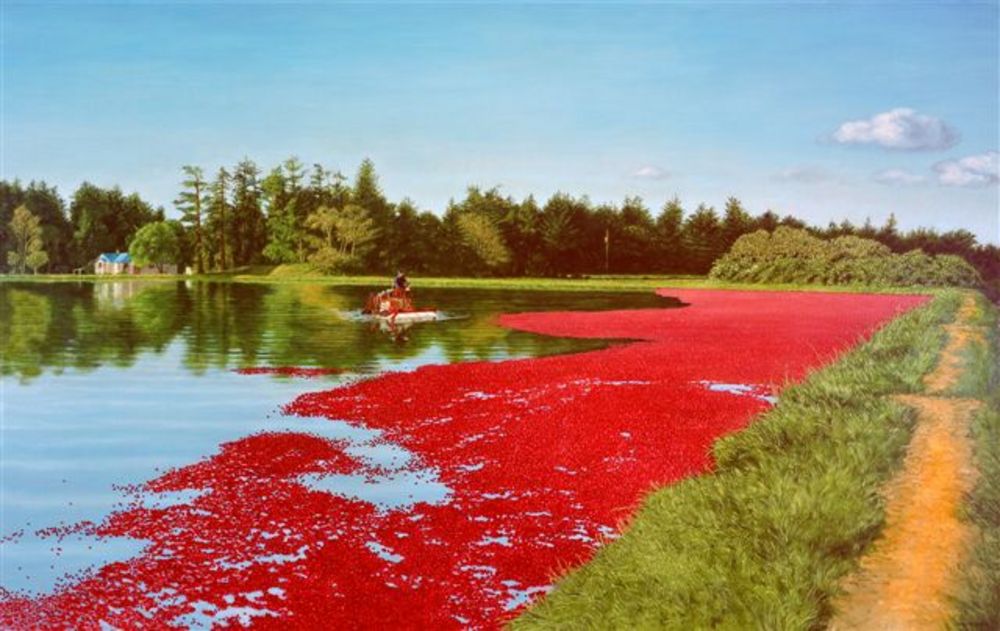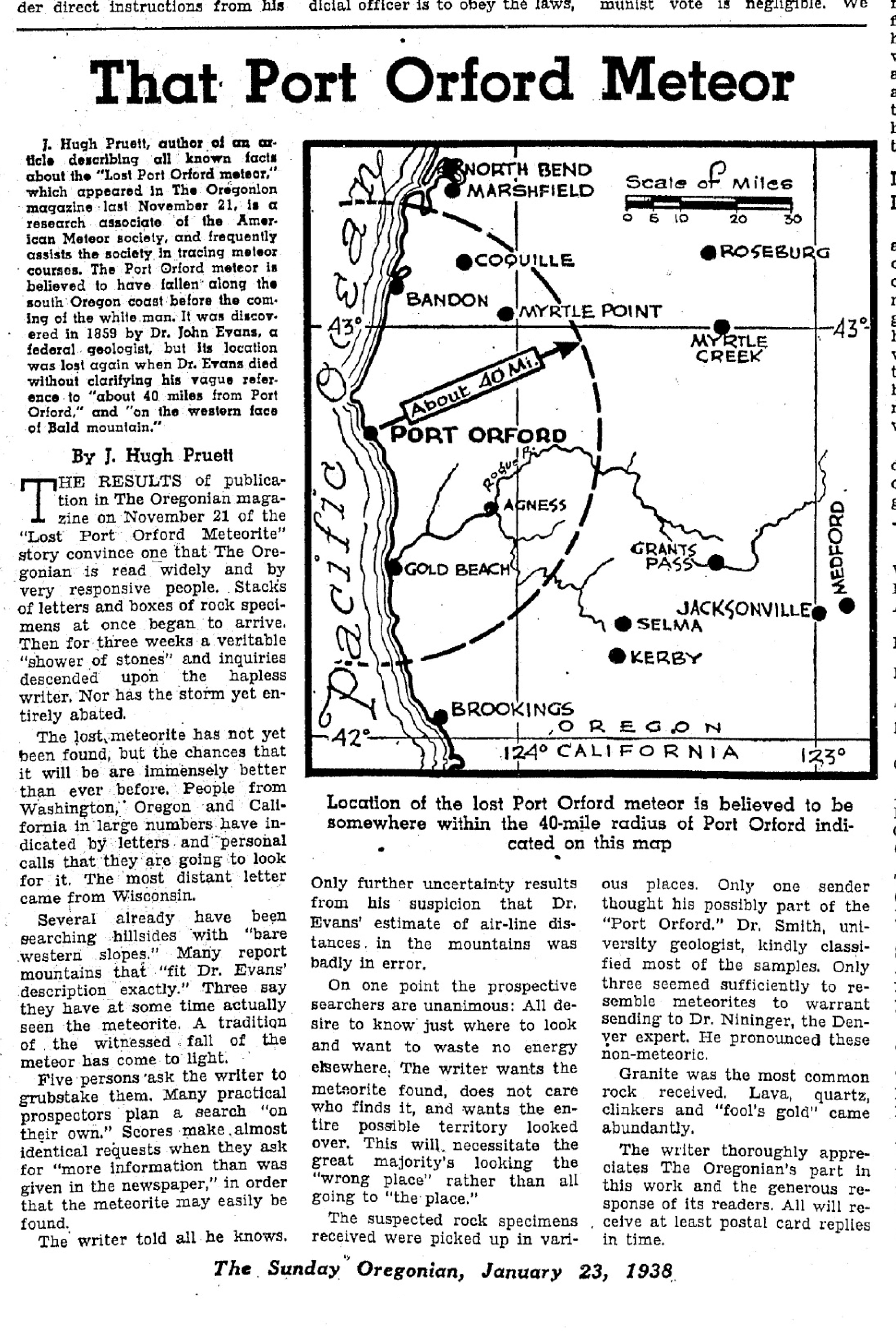Port Orford claims to be the oldest town site on the Oregon coast, dating to 1851. The Qua-toh-mah band of Athabascan-speaking Tututni people were the original inhabitants of the area. In 1851, Captain William Tichenor, believing the site could become a thriving seaport, brought a small party of would-be settlers and then sailed for supplies. Local Indians, objecting to the presence of settlers on their land, drove them off. Tichenor returned later with a larger party and established the settlement.
Port Orford, sixty miles north of the California state line, was the first county seat of Curry County when it separated from Coos County in 1855. After statehood in 1859, the seat was moved to Ellensburg (later named Gold Beach).
A forest fire destroyed Port Orford in 1868, and the town was gradually rebuilt. Early industries included gold mining, commercial fishing, lumbering, and shipping. Lumber was shipped by sea, and freighters and lumber schooners did a big business as logs were brought to local mills by horse-drawn wagons and trucks. William Winsor gave the name Port-Orford-cedar to a local tree, which was valuable for building ships and homes. Dairying and other farming also began in the surrounding area.
Gilbert Gable, an energetic and determined promoter, arrived in Port Orford from New York in the 1930s. He started mining operations and sawmills and unsuccessfully promoted a railroad connection to the interior. He spearheaded Port Orford's incorporation as a city—the first in Curry County—in 1935 and served as its first mayor. Logging and milling brought a boom to the area, which lasted from the 1940s to the 1970s.
Port Orford's high dock, home to a commercial fishing fleet, is one of only a few docks in the world where fishing and pleasure boats are lowered by crane into the open ocean and hoisted back up to trailers on the dock when they return to port.
Today, tourism and an active arts community are important to the city of 1,146. Port Orford has three "crown jewel" historic properties that attract thousands of tourists from April through October: Port Orford Heads Lifeboat Station (1934-1970), Cape Blanco Lighthouse (1870), and the Hughes House (1898) north of town.
-
![]()
Port Orford, 1888.
Oregon Historical Society Research Library, Orhi101663, photo file 877B
-
![Drawing of Fort Orford, Oregon Territory, 1855.]()
Port Orford, drawing of, 1855, bb008499.
Drawing of Fort Orford, Oregon Territory, 1855. Oreg. Hist. Soc. Research Libr., bb008499
-
![]()
Port Orford, looking east down 6th St., about 1890-1900.
Oreg. Hist. Soc. Research Libr., ba012981, photo file 877B
-
![Cape Blanco lighthouse near Port Orford, 1948.]()
Cape Blanco lighthouse, 1948.
Cape Blanco lighthouse near Port Orford, 1948. Oreg. State Archives, Oreg. State Highway Div., OHD3510
-
![Port Orford Lifeboat Station, 1930s-1940s.]()
Port Orford Lifeboat Sta, aerial, 1930s-1940s.
Port Orford Lifeboat Station, 1930s-1940s. Alan Mitchell Collec., Cape Blanco Heritage Soc., NA RG 26-DS Box 21 Fld 437
-
![Port Orford Lifeboat Station watchtower, 1930s-1940s.]()
Port Orford Lifeboat Sta, watchtower.
Port Orford Lifeboat Station watchtower, 1930s-1940s. Alan Mitchell Collec., Cape Blanco Heritage Soc.
-
![Northwesterly view south of Humbug Mountain near Port Orford, July 1952.]()
Port Orford, ocean view near, July 1952.
Northwesterly view south of Humbug Mountain near Port Orford, July 1952. Oreg. State Archives, Oreg. State Hwy Div., OHD5150
-
![Port Orford, Sep. 1962.]()
Port Orford, Sep 1962.
Port Orford, Sep. 1962. Photo Ben Maxwell, Salem Public Libr., 6700
-
![]()
Knapp Hotel, Port Orford, 1940.
Oregon Historical Society Research Library, ba012976, photo file 877B
-
![]()
Battle Rock.
Oregon Historical Society Research Library, photo file 877B
Related Entries
-
![Athapaskan Indians]()
Athapaskan Indians
According to Tolowa oral histories, the Athapaskan people of southern O…
-
![Battle of Battle Rock (1851)]()
Battle of Battle Rock (1851)
On June 10, 1851, Battle Rock—a basalt promontory at Port Orford on the…
-
![Cape Blanco]()
Cape Blanco
Windswept Cape Blanco—situated at N 42˚50'08.12", W 124˚33'51.16"—is th…
-
![Cranberry Industry]()
Cranberry Industry
The Oregon cranberry is prized for its deep red color, which growers sa…
-
![Gilbert Gable (1886-1941)]()
Gilbert Gable (1886-1941)
Although Gilbert Gable lived in Oregon for only a few years, he gained …
-
![Patrick and Jane Hughes House]()
Patrick and Jane Hughes House
Built in 1898, the Patrick and Jane Hughes House in Curry County is a s…
-
![Port Orford Cedar]()
Port Orford Cedar
Port-Orford-cedar (Chamaecyparis lawsoniana)—also known as white or Ore…
-
![Port Orford Lifeboat Station]()
Port Orford Lifeboat Station
Built by Julius Yuhasz and Arvid Olson, a U.S. Coast Guard Lifeboat Sta…
-
![Port Orford Meteorite Hoax]()
Port Orford Meteorite Hoax
The Port Orford Meteorite has captured the imagination of Oregonians fo…
Related Historical Records
Map This on the Oregon History WayFinder
The Oregon History Wayfinder is an interactive map that identifies significant places, people, and events in Oregon history.
Further Reading
Douthit, Nathan. A Guide to Oregon's South Coast History. Corvallis: Oregon State Univ. Press, 1999.
Dodge, Orville. Pioneer History of Coos and Curry Counties. Coquille, Ore.: Coos-Curry Pioneer & Historical Assn., 1969.
Peterson, Emil, and Alfred Powers. A Century of Coos and Curry. Coquille, Ore.: Coos-Curry Pioneer & Hist. Soc., 1952

